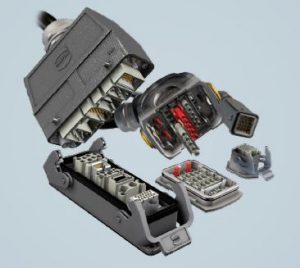 Connectivity trends according to HARTING: Connectors versus hardwiring
Connectivity trends according to HARTING: Connectors versus hardwiring
August 14, 2019 REDWIRE is news you can use from leading suppliers. Powered by FRASERS.
Posted by Harting Canada Inc
The family-owned HARTING Group is a global leader in connectivity solutions. HARTING invented the modular connector and... Read more
Subscribe
Free REDWIRE e-newsletter

Connectors are far more convenient than hardwiring, HARTING says.
In this five-part article, HARTING Canada explores the five main trends in industrial connectivity today. This first part discusses how connectors outperform hardwiring and lugging.
Connectorization versus hardwiring
When connecting an application, there are two methods: hardwiring/lugging and connectorization.
Hardwiring/lugging is defined by its permanence. The individual wires within a cable are individually connected directly to a terminal block or PCB. The intention is that the cable will never be disconnected from the application. This is because of the difficulty of uninstalling individual wires and then reinstalling them correctly.
Connectorization adds a quick way to connect and disconnect between the two points. Connectorization is so common in the consumer-electronics space that it is almost invisible.
Let’s compare these two methods through applications used in everyday life: light-switch panels (hardwiring) and coffee makers (connectorization).
A light switch panel is hardwired into your house, i.e. wires are connected directly to the back of the panel. If you’ve never changed a light switch panel out in your home, you can search online for a 16-step wikiHow tutorial. This tutorial includes steps such as “label the wires so you do not mix them up.” You need a screwdriver and wire cutters. Due to the complexity and time required, many homeowners opt to schedule an expensive electrician to come to their house, rather than deal directly with rewiring their light switch.
Now let’s compare plugging in a coffeemaker. The plug on the end of the cable plugs into a wall out. One second and it’s ready to go. It’s so easy and intuitive that there is no need for a wikiHow tutorial. This is because connectorizing is so easy and intuitive, and therefore invisible.
The same concepts discussed above can be applied to industrial applications.
Why some manufacturers choose hardwiring
Hardwiring/lugging is inconvenient. It is inconvenient for anyone who needs to install, troubleshoot, test, or maintain an application. However, for the manufacturer who designs the application or installs it once, hardwiring/lugging is a bit less expensive. The ability to connect/disconnect via a connector adds an initial labor step and a bit of material. Manufacturers who are looking to shave as much as possible off the cost to produce a product may choose to hardwire/lug.
The problem is that for anyone who uses that product, or even for the manufacturer when they install it on-site, the consequences of hardwiring have an additional, real, and volatile cost. And the one who pays that price tends to be the end user. First, the manufacturer has an electrician disconnect each wire, and then when it arrives at the end user, another electrician must come in to painstakingly connect each wire again. It is also so easy to mis-wire, which results in expensive troubleshooting costs.
Remember the light switch example above? In the tutorial, it states the importance of labeling the wires. In the case of a light switch, there are only three wires. Now imagine a machine with tens or hundreds of wires. If anything is mis-wired, troubleshooting must occur, and the end user eats the cost.
Hardwiring is frustrating. It is outdated.
Today, HARTING connectors are king
In the past few years, there has been a monumental shift away from hardwiring, towards connectorization. As machines and devices become more complex and as our world demands better efficiency and less downtime, there is no room left for the inconvenience of hardwiring.
Connectorization is time- and cost-efficient during all aspects of an application’s life cycle, from installation to maintenance and even relocation. Each of these activities is a time when a hardwired solution would be impractical, require a skilled electrician, and open up a company to unplanned, unpredictable troubleshooting costs. Connectorization, in contrast, does not require on-site skilled labour and eliminates unplanned troubleshooting.
Hardwired components have to be assembled onsite, which requires specialist electrical contractors and a lengthy testing process to ensure the wiring has been connected correctly. Plug & Play connectors can be easily linked to each other and machinery, resulting in a simple, flexible, and versatile installation experience.
For more information, contact HARTING.
Share
Posted by Harting Canada Inc
The family-owned HARTING Group is a global leader in connectivity solutions. HARTING invented the modular connector and... Read more